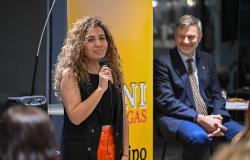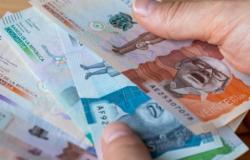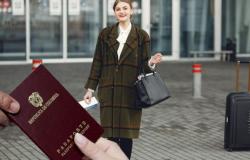
June 24, 202402:24
Hear
María Boneo entered the first grade classroom, observed the looks on her and wanted to disappear. She was a stranger among all those children, but even more so, she was a stranger in a land far from her known soil.
Everything got worse when he had to read aloud in front of his classmates: “It was torture; “I was slow and everyone laughed at me, what today we would call bullying,” remember.
The elders believed that the solution would come if they changed schools. And so, they tried various establishments where María encountered new faces and more fears, until she finally arrived at a special school, which did not bring a better horizon in that Argentina that had appeared vast and somewhat threatening.
“My friends were always smaller than me and that made me complex. I refused to go to school. These years did not leave good memories, but I always tried to understand the mistakes of adults and put humor into it. “I was a happy girl without understanding what was happening with the adults around me.”
“My brothers greatly influenced my happiness. Each of them held a special place in my life and gave me their unconditional support. My sister, Mercedes, whom I remember fondly, played the role of older sister and took tender care of me. My brother Martín, who went to live in the United States, was my playmate and was always present in my life.”
María was born on November 21, 1959 in Belgrade, Yugoslavia at that time. His father, Martín Alberto, was a career diplomat and poet. Her mother, Dora Ester Sanseverino, worked as a literature teacher and writer. Thus, from a very young age, María knew how to embrace the arts as a path of purgation and beauty in a bittersweet and fragmented world. She, along with her four older siblings -Mercedes, Elena, Patricia and Martín- soon learned that poetry could be made from tears.
The farewell that María will never forget happened in 1966, when at the age of six her parents decided to undertake the trip back to Argentina. They came from there, but for the little girl it represented a change that had a strong impact on her, and so, after crossing the ocean on the ocean liner Federico C., the new dawn brought with it battles in María’s heart that were difficult for adults to understand. , but that were burned into the girl.
“Arriving in Argentina represented a big change in our lives. I felt like no one understood me because my language was incomprehensible to others. “They thought I had some difficulty, possibly dyslexia, and that is why I was the subject of study.”
However, a tougher battle awaited. It happened when María had already turned 12, she was with her mother in Mar del Plata when she received unexpected news: his father had died of a stroke.
María could not comprehend the event, how could she believe it possible if her father was about to arrive at the coast in two days? They returned to Buenos Aires by plane, her first flight in her entire life, an event as improbable as the news she had just received: “I remember the flight as something amazing, without thinking that I was returning to say goodbye to him. Perhaps the purity of my 12 years protected me from fully feeling that hard moment.”
“For several years I dreamed that my father had left us and was with another family. As an adult, working on this issue in therapy, I dreamed about his death again, until one day I stopped dreaming about it and got over it,” María continues.
Life continued, but his existence changed drastically. The almost adolescent girl suddenly found herself faced with an unthinkable reality: everyone had to go to work, was the announcement, and without further ado, María left day school to study at night, while he spent the day working in a clothing factory, a circumstance that had a full impact on his spirit, who soon sought to find meaning in everything through a path he knew: art, where he first ventured into drawing.
“The change of life, the factory, marked the aesthetic path that would follow later. With my sister, Elena, we decided to attend Miguel Ángel Bengochea’s workshop, where I realized that drawing was not my path. At the same time, I entered the Prilidiano Pueyrredón National School of Fine Arts, in Las Heras and Callao. They were times of military dictatorship; teachers and students disappeared, and classes were frequently suspended,” remember.
“My teachers, such as Leo Vinci and Beatriz Soto García, played a fundamental role in my artistic and personal development. “Through sculpture, I found my true passion and gave myself completely to this form of expression.”
Sometimes María remembers herself as a child, when she had to learn the alphabet. Her mother always arrived tired from working and sent her to her neighbor’s house to teach her. This image from her childhood and others of her left a strong mark on her, including learning to connect with the world, beyond her immediate environment: “I have always known how to knock on doors and I have been lucky to find good people,” points out about it.
And so it was for her also on her path as an artist, at the Art School there were still traces of a hard past and María sought to differentiate herself. To do this, she became independent and strong, without a specific plan about her destiny in a world where commands ruled strongly, but where her family had always encouraged the languages of the soul.
“In my family, art was everywhere: There were painters, writers and the walls were lined with books. I read a lot, although I only watched them. But I think that on this path you have to be lucky, not just be smart.”
Over time, love and children came. María learned to combine her career as an artist with her role as mother and wife, facing the challenges and joys that her motherhood entails. In her odyssey to find balance she traveled to Carrara, Italy, in search of inspiration and improvement, and she dared to temporarily leave her family for her passion: “I am a woman, mother and artist, the order does not matter; each of these words is strong separately and together they define me. The stages of life require different attention at different times, and we evolve thanks to the risk and challenge of finding our best version.”
“Sculpture, meanwhile, is the material that gives volume to my thoughts; It is the solid, the concrete, the reality behind a plane, what is not seen in a painting. In a two-dimensional work I don’t see what happens behind. On the other hand, the sculpture has many faces. As in everything, even with words, when one says something one also refers to something else. The sculpture has life, you can touch it. In my work there is no place for the negative; My art does not bleed, it is the catharsis where I release what holds me back and where I release what frustrates me and let what is pleasurable drain.”
“The small size at the beginning is the trigger that then adapts to what the stone commands. By working on it, a dialogue begins between her and me and ‘the path is made by walking’, as Serrat would say. I never know what I’m going to find. A stone can show a vein that suddenly makes me change course and go to another unexpected place. Then I adapt and let myself go and that’s where the challenge comes and I get into the subject,” explains María.
“And I am a tremendously organized artist and my workshop also has to be neat, with the tools always in their place so I know exactly where to find what I need to work. With the clay in its correct humidity, the appropriate music and the phone on silence, I enter a climate that only I can feel. Problems stay outside and nothing contaminates my creative space. All the tools I have in my workshop are equally important to my creative process. “I couldn’t give more importance to one or the other, that would be like choosing between one child and another.”
There in the distance remained that María, the foreigner born in the former Yugoslavia, who undertook an odyssey in Argentina marked by challenging battles. The impacts are far away, although today’s woman integrates the girl, crossed by the difficulty in language, the love of her siblings, the loss of her father, hard work in the factory and the ever-present traces of a past full of Argentine chiaroscuros.
It was for many years that María tried to decipher her recurring nightmares and the emotions that marked her existence. It took her a long time to discover that the path of art was the one that would lead her to find the tip of a great ball hidden inside her: “Pulling that small thread required vulnerability and fear, which could have led me to the failure or rejection that I had already experienced, but my unconsciousness was my best ally”he reflects.
“My first therapist, Silvia, called me Thumbelina because she saw in me someone who would mark her own path and that of others. This process was challenging and essential to discover what I could be and create, especially my women with their virtues and few defects. My works, my women, I made them with noble materials such as marble, scented wood and clay, which I can model and change,” continues María, who in Girona, Spain, will be participating in an exhibition at the Essences gallery. This will be a collective exhibition in which the Japanese sculptor Hiroshi Kitamura, María Mercader and Silvia Hornig will also participate. Additionally, this year she will exhibit in Miami, at Lucid Art Gallery, as a member of Collective 62. “I am committed to these exhibitions that allow me to explore different cultural and artistic contexts. My art is a way of transmitting what I have inside, I faced many internal challenges. I would love for young artists to see something in my work, as I saw in my teachers, and for this to continue a path where art is almost infinite.”
“As an artist, I try to share a look that gives a new perspective to everything. I seek to find the essence of things, emotions and what surrounds me, making the risk worth it,” she says thoughtfully. “I followed a different path, leaving what I didn’t like, and I chose to continue without stopping. I finally found identity and value, something that no one had given me before. It was lucky? “I am a lucky person, yes,” concludes.
*
If you want to share your experience you can write to [email protected]





